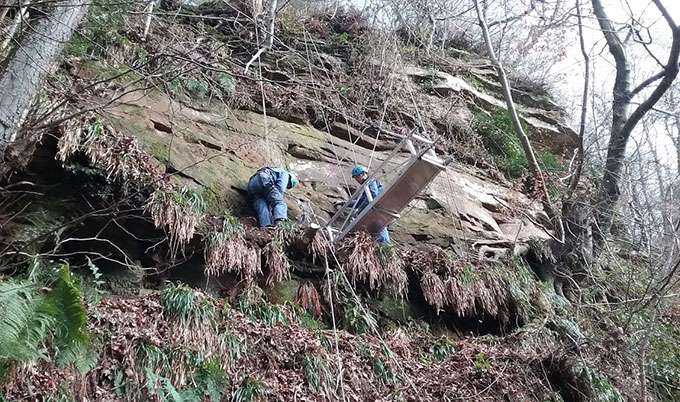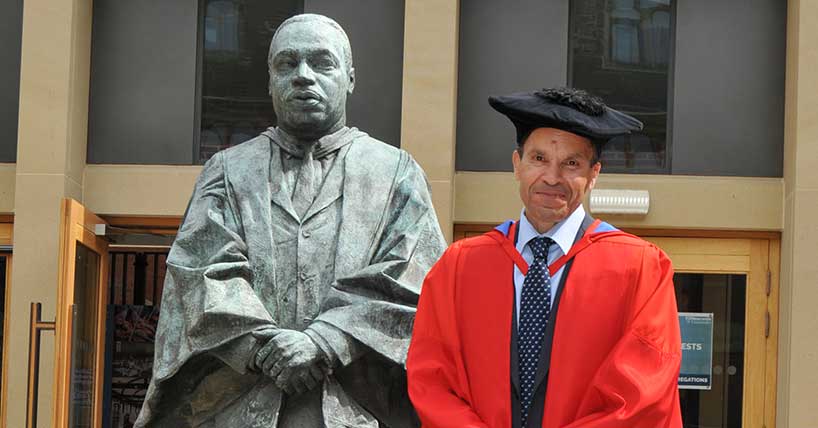archaeology awards
Archaeology expertise recognised at national awards
Published on: 6 March 2020
Two research projects co-led by Newcastle University archaeologists have been successful at the national Current Archaeology awards.
Archaeology by abseiling
A project to record graffiti left by Roman soldiers when quarrying stone to repair Hadrian’s Wall won Rescue Project of the Year at the awards.
The site, known as ‘The Written Rock of Gelt’, provides evidence of rebuilding and repair work to the Roman frontier in the early third century AD, a period when Hadrian’s Wall underwent a major repair and renewal programme.
The inscriptions - carved into the quarry walls in AD 207 at Gelt Woods, Cumbria - have suffered in recent years because of the gradual erosion of the soft sandstone into which they were cut. Additionally, the collapse of a path up to the site in the early 1980s put a halt to the public being able to view the inscriptions.
The sensitivity of the site and the challenge of accessing the face, some nine metres above the ground, meant that researchers were previously unable to offer a definitive interpretation of the Latin text and the range of images depicted.
Jon Allison, an archaeologist at Newcastle University, abseiled down the quarry face to produce a 3D record of the graffiti using structure-from-motion (SfM) photogrammetry to capture the inscriptions and safeguard them for further study before they are lost to the elements forever.
The work also revealed new inscriptions and some that were previously thought to be lost.
As well as recording the graffiti and the condition it is currently in, the project, which was carried out in partnership with and is funded by Historic England, is allowing the public to view the Roman inscriptions via the Sketchfab 3D media platform.

Extreme climate change
The Research Project of the Year award was won by 'Life beside the lake: opening a window on the Mesolithic at Star Carr'. This is the second time this project has won this award. The research was based on more than ten years of work at Britain’s most important Mesolithic site – Star Carr, near Pickering, North Yorkshire.
Excavations at the site were directed by Dr Chantal Conneller working with colleagues at the Universities of York and Chester.
Their research revealed two episodes of dramatic and sudden cooling of the climate which saw average temperatures drop by more than three degrees in the space of a decade.
The first of these events occurred very early after humans began to return to the area after the last ice age, and the work at Star Carr has revealed that people quickly made this new landscape home.
The excavations uncovered Britain’s earliest house, one of three such structures on the site. Also discovered were three large timber platforms revealing a previously unknown scale of building at this time. A new dating programme reveals that people revisited the site for more than 800 years.
“Star Carr has produced an incredibly rare glimpse into the world of our Mesolithic ancestors who lived just after the end of the ice age, about 11,000 years ago,” Dr Conneller explained. “Star Carr was once the site of an extensive lake, with people living around its edge. However, over time the lake gradually became shallower and boggier. This has led to excellent preservation of finds which do not normally survive; however the site has been drying out and we had to race against time to recover the remaining artefacts.”
The team have found ritual costumes made of red deer skulls, a unique decorated bead, hunting equipment, digging sticks and animal remains that seem to represent the debris from communal feasts.
The awards were voted for entirely by the public and were announced as part of Current Archaeology Live! 2020.
Professor Helen Berry, Head of the School of History, Classics and Archaeology, said: “These awards recognise the dedication and painstaking work over many years that has gone into these two very different research projects. To be selected as winners by the public is a great achievement and both teams deserve huge congratulations.”



